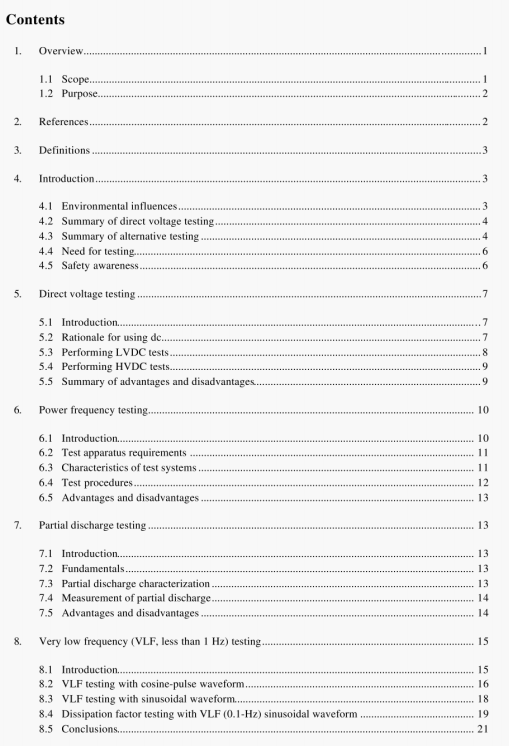IEEE Std 400:2001 pdf free download.IEEE Guide for Field Testing and Evaluation of the Insulation of Shielded Power Cable Systems.
A major objection to Type I Field Tests is the concern that application of increased voltages without any other accompanying diagnostic measurements triggers failure mechanisms that will not show during the test but that may cause subsequent failures in scrvicc. The selected test voltages can be uscd not only to force cable systems to fail at die sites of defects, but also to provide a useful evaluation of the condition of the insulation system.
As cable system insulations age, their dielectric properties undergo characteristic changes. These can be used to perform various Type 2 (Diagnostic) Field Tests A brief overview of the known methods follows:
— For defective cable insulation, the dc leakage current versus voltage plot departs from linearity as the voltage is increased beyond some threshold value (tip-up curve), allowing a simple diagnostic lest to be performed in the field.
Another set of tests consists of applying a moderately elevated direct voltage across the cable insulation. removing the voltage source, shorting the cable while monitoring the short-circuit current as a function of time (depolarization current test), or measuring the voltage buildup as a function of time after the removal of the short (return voltage test). The rate of depolarization current decay or the rate of return voltage buildup can be used as indicators of the degree of insulation aging. Measurement of polarization index (Ratio of insulation resistance after 10 mm to resistance after 1 minute of a voltage application) can also be utilized as an insulation diagnostic test.
As a cable deteriorates, its dissipation factor (tan 8) versus voltage plots can assume a gradually higher rae of increase (tip-up) beyond some threshold voltage. This lest can be conducted either by means of a power frequency voltage or by means of a VLF voltage.
— Water treeing in extruded cables causes a slight rectification of the ac voltage impressed across their insulation, producing a very small dc component in the ac leakage current. The magnitude of this component has been shown to increase with the severity of treeing.
Another developing diagnostic test, propagation characteristics spectroscopy (P(’S). monitors the changes in the wave propagation characteristics (attenuation versus frequency spectrum) of a cable by means of a low-voltage pulse that can be applied while the cable is energized and in service. Experiments have shown that the attenuation spectrum changes characteristically as the insulation ages.
IEEE Std 400:2001 pdf free download
